Kenta Furukawa, Masakazu Yamashita
Department of Environmental Systems Science, Doshisha University, 1-3 Miyakodani, Tatara, Kyo-tanabe, Kyoto, 610-0394, Japan
Correspondence to: Masakazu Yamashita, Department of Environmental Systems Science, Doshisha University, 1-3 Miyakodani, Tatara, Kyo-tanabe, Kyoto, 610-0394, Japan.
| Email: |  |
Copyright © 2014 Scientific & Academic Publishing. All Rights Reserved.
Abstract
Next-generation automobiles have been attracting attention to replace existing gasoline-fueled ones and reduce its consumption. In Japan, sales of the Toyota Prius, a synonym for hybrid vehicles, have been ranked in the top 3 since June 2011. As this shows, people living in modern society consider that “hybrid vehicles are environmentally friendly”. The present paper discusses whether or not: next-generation automobiles are more environmentally friendly than gasoline-fueled vehicles; and they should be promoted. According to the results, hybrid automobiles are the most efficient when the mean total lifetime mileage is 120,000 km. However, gasoline-fueled automobiles will also continue to be purchased because small-sized and light automobiles do not have to be equipped with the hybrid system. Therefore, as a conclusion, the number of hybrid automobiles will not exceed that of gasoline-fueled automobiles even in the future. The paper also discusses the validity of the selection of hybrid and electric automobiles. Although the raw fuel-based internal energy efficiency of electric automobiles was higher, there was no significant difference in the mileage between the two types when the fuel and electricity energy efficiencies were taken into account. Furthermore, when the power of a hybrid automobile and electric one was the same, the energy efficiency of the former was higher. In other words, if a hybrid automobile is thermally powered using crude oil, the driving distance may be larger depending on the power generation efficiency. The actual fuel efficiency of hybrid automobiles was as high as that of electric ones, since there was no difference in the electricity energy efficiency between the two types. An examination was also conducted to determine whether or not “the energy efficiency of electric automobiles is the highest of all passenger vehicles”. Based on the results, we concluded that hybrid automobiles are more energy efficient from the viewpoint of the lifetime mileage.
Keywords:
Next-generation automobiles, Hybrid, Electric, Gasoline, Cost
Cite this paper: Kenta Furukawa, Masakazu Yamashita, Valuation of Next-generation Automobiles Judging from Commercially Available Automobiles, World Environment, Vol. 4 No. 2, 2014, pp. 80-92. doi: 10.5923/j.env.20140402.05.
1. Introduction
There has been a concern over global warming, and greenhouse gas reduction is an urgent task for us. Greenhouse gas mainly consists of carbon dioxide (CO2) [1], and gasoline-fueled automobiles are the main source of CO2 emission in most countries.In Japan, CO2 emission from the transportation industry accounted for 19.5% of the total in 2010 - 88.2% of which was from automobiles, including passenger automobiles (50.4%) [2]. This means that CO2 emitted from passenger automobiles accounts for approximately 8.7% of the total, or 116.8 million tons [3].Petroleum consumption reduction is not only a measure to address global warming, but it has also attracted attention as an energy issue. Although almost 100% of the energy consumed by the transportation industry is currently generated from petroleum, it is a finite natural resource, and proven reserves for only 40 to 50 years are left. Therefore, energy conservation efforts have been made in Japan - a country that has no choice but to rely on imported fuels. In this context, the Ministry of Economy, Trade and Industry published the “New National Energy Strategy” in 2006 for “environmental improvements required to reduce the petroleum dependence rate in the transportation field to around 80% by 2030” [4]. Even though it is believed that fossil fuels will soon be depleted [5], most of the automobiles currently used are gasoline-fueled. Among next-generation automobiles, electric cars are currently attracting attention, which are expected to decrease the petroleum dependence rate and CO2 emission while driving; CO2 emission from passenger automobiles accounts for the majority of the total CO2 emission from the transportation industry [6, 7, 8].The following types of automobile are currently used: 1) gasoline-fueled, 2) hybrid, 3) plug-in hybrid, 4) electric, 5) fuel-cell, and 6) new-fuel (natural gas, bioethanol, methanol, hydrogen, etc.). In Japan, sales of the Toyota Prius, a synonym for hybrid vehicles, had been ranked first from June 2011 through September 2012, and are still in the top 3, which suggests the popularity of hybrid automobiles [9]. People living in modern society consider that “hybrid vehicles are environmentally friendly”. Are next-generation automobiles more environmentally friendly than gasoline-fueled vehicles? Should they be promoted? To answer these questions, it is necessary to assess the environmental effects of next-generation automobiles from the viewpoints of fuel usage and its cost.An eco-car, a term frequently seen and heard in recent years, refers to a small-sized, next-generation automobile that has a minimal load on the environment [10]. The following are three levels of eco-car used by different people and in specific regions: Low-emission vehicles that produce smaller amounts of harmful substances than existing automobiles
Low-emission vehicles that produce smaller amounts of harmful substances than existing automobiles Low-emission, energy-saving vehicles with improved fuel efficiency
Low-emission, energy-saving vehicles with improved fuel efficiency Next-generation automobiles developed using innovative technologies to replace existing vehiclesDiesel automobiles in Europe are classified as Level 1. Many people in Japan consider that diesel automobiles have adverse effects on the environment because they emit SPM and NOx. In Europe, newly developed clean diesel vehicles are popular because they produce smaller amounts of air pollutants and run on light oil, which is cheaper than gasoline [11]. Actually, clean diesel vehicles do not really prevent environmental pollution, except for the advantage of running on inexpensive light oil. A manufacturer named them clean diesel vehicles to lead European consumers to think that the vehicles are environmentally friendly. As a result, the vehicles are sometimes referred to as eco-cars in European countries.In Japan, level-2 energy-saving automobiles are covered by the eco-car tax break program. In addition to emission controls for Level-1 automobiles, standards for fuel efficiency have also been established. The standards, which are designed to reduce CO2 emissions in a short period of time and apply to both diesel and gasoline-fueled automobiles, are only vaguely defined.Level-3 automobiles include the vehicles stated in 2) to 6) of the preceding paragraph.Hybrid automobiles differ from gasoline-fueled ones in that they are also equipped with a motor, in addition to an engine, which serves to significantly reduce energy output from the engine while driving at a low speed [12]. Hybrid automobiles combine the conventional engine with a motor, which generates electricity, to markedly improve their fuel efficiency.Hybrid automobiles are no longer covered by the government’s subsidy program as next-generation automobiles. However, they may be viewed as next-generation vehicles in a sense because they are equipped with a type of motor not adopted by conventional automobiles, based on new technologies.Electric automobiles refer to vehicles that run only on electricity without using gasoline. They emit no CO2 at all while driving. They are promising automobiles equipped with a motor, which increases the energy efficiency more, compared to a conventional engine.Although plug-in hybrid automobiles usually run on electricity, they can continue running even when no electricity is supplied, using gasoline, as hybrid vehicles. As existing electric automobiles cannot run a long distance, plug-in hybrid automobiles are used in such a case.Fuel-cell-powered automobiles are expected to be promoted more widely with the recent progress in fuel cell technology. This type of automobile uses natural gas to produce hydrogen, which reacts with oxygen to generate electricity. However, the automobile uses platinum for its electrodes, and there are a number of challenging tasks, including cost-related problems.In Japan in particular, the government’s subsidy applies to automobiles as defined in 3) to 5) of the preceding paragraph, which comply with the “New National Energy Strategy” to break free from dependence on petroleum. This clearly shows that the government recommends these automobiles.
Next-generation automobiles developed using innovative technologies to replace existing vehiclesDiesel automobiles in Europe are classified as Level 1. Many people in Japan consider that diesel automobiles have adverse effects on the environment because they emit SPM and NOx. In Europe, newly developed clean diesel vehicles are popular because they produce smaller amounts of air pollutants and run on light oil, which is cheaper than gasoline [11]. Actually, clean diesel vehicles do not really prevent environmental pollution, except for the advantage of running on inexpensive light oil. A manufacturer named them clean diesel vehicles to lead European consumers to think that the vehicles are environmentally friendly. As a result, the vehicles are sometimes referred to as eco-cars in European countries.In Japan, level-2 energy-saving automobiles are covered by the eco-car tax break program. In addition to emission controls for Level-1 automobiles, standards for fuel efficiency have also been established. The standards, which are designed to reduce CO2 emissions in a short period of time and apply to both diesel and gasoline-fueled automobiles, are only vaguely defined.Level-3 automobiles include the vehicles stated in 2) to 6) of the preceding paragraph.Hybrid automobiles differ from gasoline-fueled ones in that they are also equipped with a motor, in addition to an engine, which serves to significantly reduce energy output from the engine while driving at a low speed [12]. Hybrid automobiles combine the conventional engine with a motor, which generates electricity, to markedly improve their fuel efficiency.Hybrid automobiles are no longer covered by the government’s subsidy program as next-generation automobiles. However, they may be viewed as next-generation vehicles in a sense because they are equipped with a type of motor not adopted by conventional automobiles, based on new technologies.Electric automobiles refer to vehicles that run only on electricity without using gasoline. They emit no CO2 at all while driving. They are promising automobiles equipped with a motor, which increases the energy efficiency more, compared to a conventional engine.Although plug-in hybrid automobiles usually run on electricity, they can continue running even when no electricity is supplied, using gasoline, as hybrid vehicles. As existing electric automobiles cannot run a long distance, plug-in hybrid automobiles are used in such a case.Fuel-cell-powered automobiles are expected to be promoted more widely with the recent progress in fuel cell technology. This type of automobile uses natural gas to produce hydrogen, which reacts with oxygen to generate electricity. However, the automobile uses platinum for its electrodes, and there are a number of challenging tasks, including cost-related problems.In Japan in particular, the government’s subsidy applies to automobiles as defined in 3) to 5) of the preceding paragraph, which comply with the “New National Energy Strategy” to break free from dependence on petroleum. This clearly shows that the government recommends these automobiles.
2. Study Methods
Patterns of the use of automobiles were first discussed. The total distance a person is expected to drive during his/her lifetime was estimated based on the driving distance per trip, day, and year. In the present study, whether or not a type of automobile should be introduced is decided based on this lifetime driving distance.A history of improvements in automobile fuel efficiency was also discussed to examine its relationship with the number of automobiles owed by households. The present study also examined the processes in which hybrid automobiles have been and will be further promoted, although they have not yet become the mainstream to replace gasoline-fueled automobiles.An analysis of the energy balance was also conducted. In the case of an electric automobile: | (1) |
In the case of a gasoline-fueled automobile: | (2) |
This calculation method is referred to as “well-to-tank” [13]. Differences in the distance covered by hybrid (next-generation) and electric automobiles per unit of crude oil were examined (raw fuel-based calculation). The unit “km/L” used to express the “fuel efficiency” of a hybrid automobile was converted into “km/kWh” - a unit used to express the calorific value of gasoline, or “electric energy efficiency” of an electric automobile. As the actual fuel efficiency reflects the energy efficiency in real life, the actual electric energy efficiency of an existing electric automobile was determined while taking into account differences between hybrid and electric automobiles.When hybrid and electric automobiles run a certain distance, the gasoline and electricity prices, respectively, significantly influence the driving cost. Changes in the total costs for different driving distances due to increases in the prices of gasoline and electricity were examined.The total cost “C” is calculated using the following formula when the price of an automobile is V [yen], driving distance is X [km], fuel (electricity) efficiency is Y [km/L (km/kWh)], and fuel cost is A [yen/L and yen/kWh]: | (3) |
This graph was used to examine whether or not the price differences can be compensated for depending on the lifetime mileage.An electric automobile is equipped with a large volume of lithium ion batteries and very expensive. There has been a decrease in the price of lithium ion batteries. A calculation was performed to determine to what extent a reduction in the price difference, due to the reduced price of lithium ion batteries, compensates for the disadvantage of shorter driving distances. The level of price reduction required for the adoption of electric automobiles to be effective was determined, based on the graph.Finally, the dissemination of these automobiles in the future was predicted. Table 1 shows an estimation, based on the NEDO Road Map [14], of target levels that are predicted to be accomplished through technological progress (from 100,000 to 200,000/kWh in 2005) when the price of the lithium ion battery is x yen/kWh.Table 1. A summary of lithium ion batteries based on the NEDO Road Map [14]
 |
| |
|
Based on the reduction, future changes in the sales of electric automobiles were predicted. An assumption was made, based on the prevalence of hybrid automobiles, as stated in 3.1, that the price difference is compensated for when an electric automobile starts to sell at the same rate as the Prius.
3. An Examination of the Patterns of Automobile Usage, Improvements in the Fuel Efficiency, and Status of Dissemination
3.1. An Examination of Usage Patterns and Setting of the Lifetime Driving Distance
The introduction of next-generation automobiles should be decided based on the annual driving distance, expected life (the driving distance covered during the lifetime of a person), and driving performance.In general, the driving distance covered by an automobile during a person’s lifetime is believed to be approximately 100,000 km. The following are the results of an estimation of the driving distance covered by passenger automobiles, driven for fun and business and on weekdays and holidays, as shown in Figures 1 to 4 [15]. | Figure 1. Numbers of trips for fun on weekdays and automobiles (a: standard-sized automobiles, b: light automobiles) |
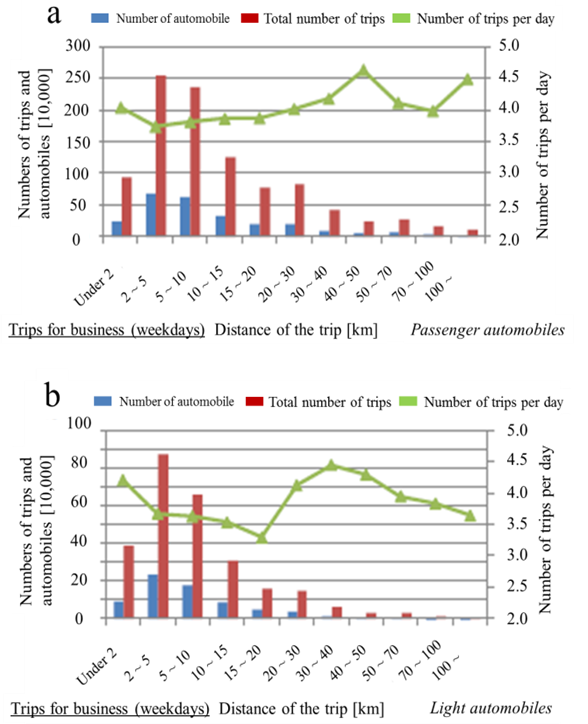 | Figure 2. Numbers of trips for business on weekdays and automobiles (a: standard-sized automobiles, b: light automobiles) |
 | Figure 3. Numbers of trips for fun on holidays and automobiles (a: standard-sized automobiles, b: light automobiles) |
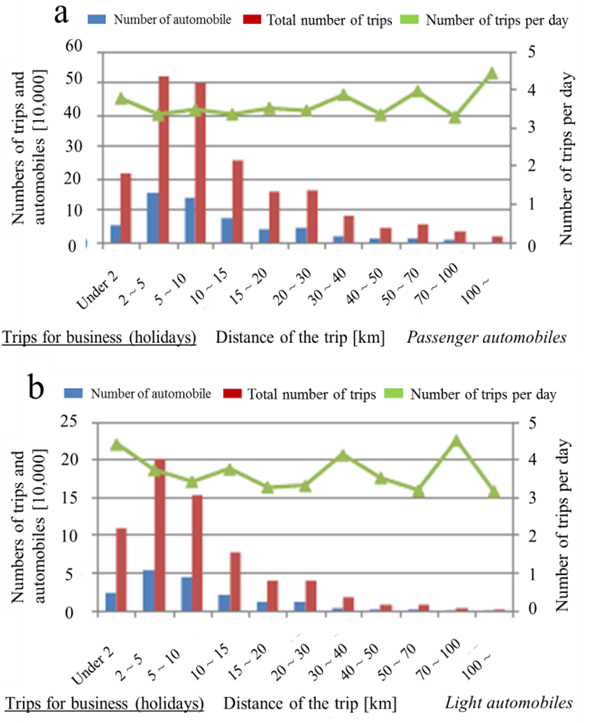 | Figure 4. Numbers of trips for business on holidays and automobiles (a: standard-sized automobiles, b: light automobiles) |
A trip is defined as an act of moving from one point to another, conducted by a person for a specific purpose. Therefore, each trip has one purpose. A move to a destination for one purpose is regarded as one trip, even if it involves multiple transportation means, and the second trip starts from the moment the traveler has a second purpose. The total number of trips is calculated by summing up the number of trips conducted by each person. Most of the trips were within 30 km. Figure 5 shows the daily mean distance actually run by automobiles based on the number of trips [15]. | Figure 5. Distribution of the daily mean distance actually run by automobiles (a: standard-sized automobiles, b: light automobiles) |
The numbers of passenger automobiles running 40 and 50 km or less (during both the peak period and actual working hours) account for approximately 70 and 90% of the total. The numbers of light automobiles running 30 and 40 km or less (during both the peak period and actual working hours) account for approximately 70 and 90% of the total.Table 2 shows statistics for automobile transportation, and the driving distance and fuel efficiency of automobiles stated in the 2010 annual report on the statistics of automobile fuel consumption [16].Table 2. Statistics of fuel efficiency according to the type of automobile [16]
 |
| |
|
Therefore, the driving distance covered by an electric automobile commercially available at present is determined to be approximately 100 to 200 km. Figure 6 shows the annual driving distance and numbers of each type of automobile [15].Based on Figure 6, the annual driving distance of a standard-sized automobile was determined as 12,000 km, and the maximum driving distance was set at 120,000 km on the assumption that it runs for ten years.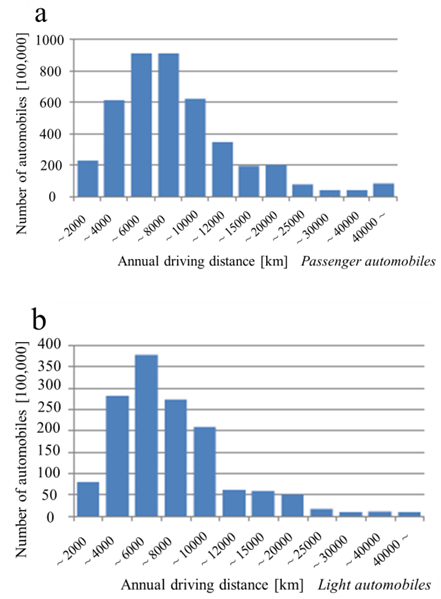 | Figure 6. Distribution of the annual driving distance covered by different automobiles (a: standard-sized automobiles, b: light automobiles) |
3.2. Changes in the Fuel Efficiency and Dissemination Rate of Automobiles
Figure 7 shows mean changes in the fuel efficiency of automobiles published by the Japan Automobile Manufacturers Association [17].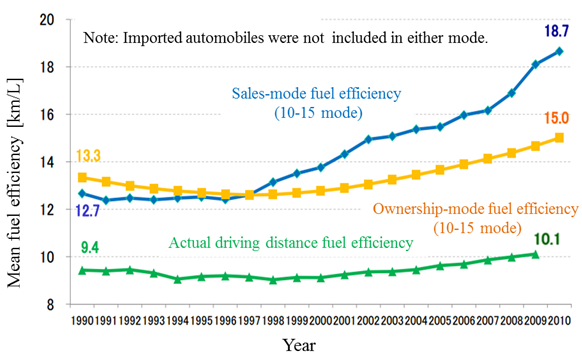 | Figure 7. Changes in the mean fuel efficiency of automobiles |
As shown in the figure, there has been a notable increase in the fuel efficiency in recent years. The causes of the increase include the idling-stop and CVT systems primarily adopted by small and compact automobiles as well as the entry of hybrid automobiles into the market.During the 20 years between 1990 and 2010, the fuel efficiency stated in the specification and calculated while driving increased by 47 and 18%, respectively. The fuel efficiency while an automobile is actually running on the road is significantly lower than that published by an automobile manufacturer. The actual fuel efficiency has increased by 11% during the past 20 years, which suggests that there are significant differences between this and the 10-15 modes. The Ministry of Land, Infrastructure, Transport and Tourism has established the standards shown in Figure 8 [18]. The standards for the fuel efficiency in the 10-15 mode were reached earlier than expected.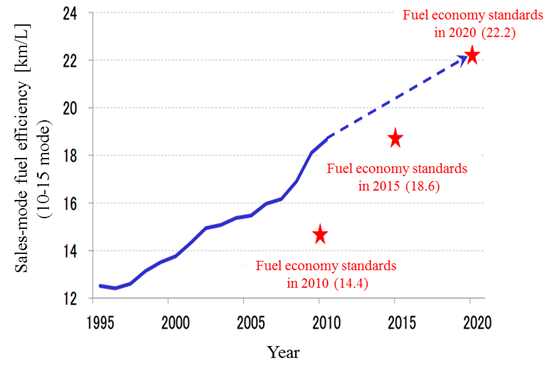 | Figure 8. Changes in the Sales-mode fuel efficiency of automobiles |
The fuel efficiency of the Prius was 31.0 km/L when it was brought into the market in December 1997 for the first time, and its major (in December 1997) and minor (in September 2003) model changes improved the figure to 35.5 and 38.5 km/L, respectively [19]. Functions in Figure 9, calculated using the least squares method, represent changes in the fuel efficiency during the period until 2030, estimated based on the previous 10-15 mode fuel efficiencies. Although the fuel efficiency has been increasing, it may not continue improving in the future. However, the present study adopted this estimated fuel efficiency increase rate to compare the Prius to future electric automobiles. The plots represent the fuel efficiency of the Prius series. The fuel efficiency of the 2004 and 2009 models in the JC08 mode was 29.6 and 32.6 km/L, respectively. The increase rate of fuel efficiency for both models was 0.6 km/year.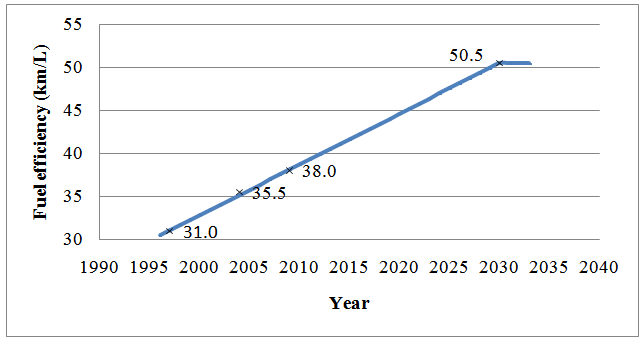 | Figure 9. A prediction of changes in the fuel efficiency of the Prius |
The 2012 (January to December) new automobile sales ranking also suggests the popularity of hybrid automobiles: the Prius and Aqua ranked first and second, respectively. The Honda Fit is also equipped with the hybrid system, and this also contributes to the strong sales of hybrid automobiles (Table 3) [9].As the sales of new passenger automobiles are approximately three million, the Prius and Aqua alone account for 19.4%, and the Fit Hybrid, Freed Hybrid, and other hybrid automobiles account for more than 20% of the total. Table 3 shows the sales (new ones) and number of hybrid automobiles registered, and Figure 10 shows changes in these numbers [9, 20, 21].The increase from 2009 is attributed to increased fuel efficiency due to the model change to the Prius in May 2009 and the launch of the third (or current) version of the Prius in 2003. Figure 11 shows a prediction of the dissemination of hybrid automobiles based on data between 2008 and 2011.In 2011, the sales of hybrid automobiles accounted for 26.5% of the total sales of new passenger automobiles; the entry of the Aqua into the market in December 2011 has presumably increased the popularity. Furthermore, as shown in Table 3, there have been increases not only in the actual sales of the Prius but also in the proportion of its sales to the total sales of new passenger automobiles, which suggests an increasing popularity of hybrid automobiles.Figure 11 shows that the number of hybrid automobiles as a proportion of the total is expected to further increase. If they continue to increase at this rate, the proportion will be 28.1% in 2030 - one out of four automobiles will be a hybrid automobile; or even one out of three, depending on the functional improvement of hybrid automobiles, as shown in Figure 9 or described in the preceding paragraph. On the other hand, if the price of electric automobiles decreases and the number of people who prefer them to hybrid automobiles increases, the rate of the dissemination of hybrid automobiles may decline.Table 3. Ranking of the sales of new passenger automobiles in 2012 [9]
 |
| |
|
Table 4. The sales of new hybrid automobiles, their number, and proportion to the total [9, 21]
 |
| |
|
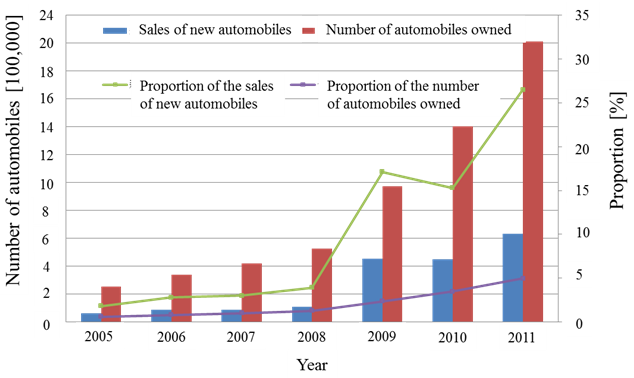 | Figure 10. Changes in the sales of new hybrid automobiles and their number |
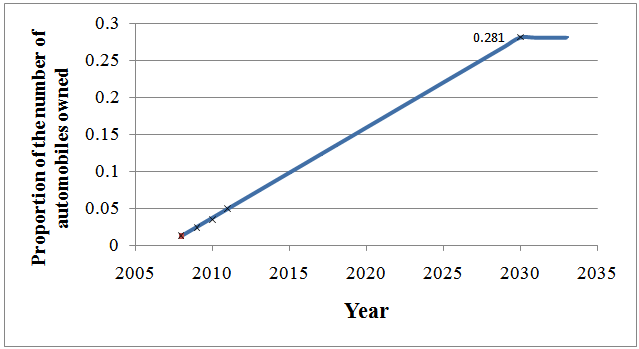 | Figure 11. An estimation of changes in the proportion of the number of hybrid automobiles |
The sales of electric automobiles have also been increasing. The sales of plug-in hybrid automobiles were only about 200 in 2010, and the figure increased to 3,700 in 2011. The sales of standard-sized and compact electric automobiles increased from approximately 4,500 to 8,600, and from 2,600 to 4,600, respectively, between 2010 and 2011. The leaf is the best-selling standard-sized electric automobile, and sales of the iMiEV account for the largest proportion of the total; most of them are used for work (taxis, commercial vehicles, etc.). Electric automobiles have yet to become popular, as indicated by their sales - lower than those of hybrid automobiles. Furthermore, the promotion of these automobiles is still associated with difficulty because they are not purchased at list prices and subsidies are used to disseminate them.Electric automobiles are not widely distributed for three reasons:1) In general, the price is high; even the most inexpensive type sells for more than two million yen. The main cause is the high price of lithium ion batteries.2) Since the infrastructure is inadequate, there is concern that, during long-distance driving, the automobile may run out of battery power in areas without charging equipment.3) Since even a fully charged electric automobile cannot run a long distance, concern remains about using it for a trip and long-distance driving.Regarding electric automobiles, it is necessary to develop the infrastructure and increase the energy density of lithium batteries so that the mileage can be extended. However, as it will be unnecessary to lengthen the distance covered by a fully charged electric automobile if the infrastructure is further developed, as indicated by the preceding data, assessment for the adoption of automobiles focused on their prices on the assumption that their dissemination is most influenced by the prices.
4. Comparison of the Energy Efficiency of Automobiles
Firstly, different forms of energy are used by gasoline-fueled and electric automobiles. The sources of power for gasoline-fueled and electric automobiles are engines and motors, respectively. In an examination of the energy efficiency of automobiles, differences in the method for power generation should be taken into consideration.
4.1. Energy Efficiency of Gasoline-fueled Automobiles
The energy efficiency of a gasoline-fueled automobile is calculated using the following formula [22]: | (4) |
The mean driving efficiency of hybrid automobiles, which use both an engine and motor while driving, was 30% - higher than that of gasoline-fueled automobiles. The energy efficiency was estimated to be approximately 0.20 to 0.25.
4.2. Energy Efficiency of Electric Automobiles
The energy efficiency of an electric automobile is calculated using the following formula: | (5) |
The environmental performance of electric automobiles was significantly higher than that of other automobiles.These results may lead you to think that the performance of the Honda Super Cub, a motorbike, is higher than that of the Toyota Prius and even electric automobiles.Of course, the fuel efficiency of the Prius is significantly lower than that of the Super Cub at present when considered from a technological point of view. Energy efficiency is an index representing the power of an engine or transmitter, but not an automobile itself. When two automobiles are equipped with the same engine, the fuel efficiency of the lighter vehicle is usually higher.This suggests that an electric automobile is heavier than a hybrid automobile in the same performance rank. In other words, electric automobiles are superior if the above-mentioned conditions are not taken into account. Therefore, the driving performance was compared while taking into consideration the fuel and electric energy efficiency to determine which type of automobile is superior on the basis of raw fuel.
4.3. In the JC08 Mode
As the AC power consumption rate of the Nissan Leaf in the JC08 mode is 114 Wh/km, the electric energy efficiency is 8.77 km/kWh. The calculation is based on fully-charged batteries. If the loss of electricity in the processes of electric generation, transmission, and charge is taken into account, the raw fuel-based electric energy efficiency in the JC08 mode is expressed using the following formula when the power generation efficiency is 40%: | (6) |
As the fuel efficiency of the L-Grade Prius is 32.6 km/L, when the loss in the processes of petroleum refinery and transportation is taken into account, the raw fuel-based electric energy efficiency in the JC08 mode is as follows: | (7) |
When the gasoline calorific value is 34.4 MJ/L, [12] the formula is expressed as follows by converting the unit [L] into [kWh]: | (8) |
If the raw fuel-based power is 100 kWh, the total amount of power that can be accumulated in an electric automobile is expressed as follows: | (9) |
As the driving distance per [kWh] of the Leaf is 8.77 km, the mileage is 300 km. In the case of the Prius, the raw fuel-based energy amount is calculated using the following formula: | (10) |
The electric energy efficiency is calculated as follows: | (11) |
The Prius runs 301 km on this fuel; there is little difference between an electric automobile and the Leaf. Although the weight of an electric automobile is heavier than that of the Prius, almost the same driving distance is covered by the two automobiles, which suggests that the energy efficiency of the former is higher.The above-mentioned calculations used ideal values. The Leaf - an electric automobile, sometimes fails to complete the full distance of 228 km, and its electric energy efficiency may be lower than that stated in the specification. It is also difficult for the Prius - a hybrid automobile, to maintain a high fuel efficiency of 32.6 km/L.Therefore, the actual fuel efficiency, the one calculated when an automobile is actually running on the road, should be adopted, rather than conventional Japanese methods for the measurement of the fuel efficiency, such as those in the 10-15 and JC08 modes. In the present study, correction factors were set to calculate the actual fuel efficiency [23].If the actual fuel efficiency is represented by [faHV] and the fuel efficiency in the 10-15 mode is [fmHV], the relation is expressed using the following formula: | (12) |
The actual fuel efficiency of the Prius is calculated as 22.1 km/L. In a similar manner, if the actual fuel efficiency of a gasoline-fueled automobile is represented by [fav] and the fuel efficiency in the 10-15 mode is [fmv], it leads to the following equation: | (13) |
The actual fuel efficiency of the L-Grade Prius is 23.9 km/L, which is converted into 2.21 km/kWh on the basis of raw fuel.The Leaf is also unable to complete a distance of 228 km (in the JC08 mode) - the driving distance stated in the specification. When the raw fuel-based energy efficiency of an electric automobile is 2.21 km/kWh, its electric energy efficiency is 6.46 km/kWh.Therefore, the raw fuel-based energy efficiency of an electric automobile that can run a distance of 155 km is similar to that of a hybrid automobile.According to Mitsubishi Motors Corporation, the i-MiEV, an electric automobile, which runs 160 km when it is completely charged, drives 100 km in Okazaki City, 120 km on congested roads in the Tokyo metropolitan area, and 80 km on highways [24]. Therefore, if the actual electric energy efficiency when automobiles run 50 to 75% of the maximum driving distance is adopted, the following are suggested: a driving distance of 168 km (74% of the maximum driving distance) is consistent with the above-mentioned driving performance; the raw fuel-based energy efficiency of hybrid automobiles is almost the same as that of electric automobiles in terms of both the actual fuel efficiency and that stated in the specification.In other words, as almost the same driving distance can be covered by electric automobiles using petroleum-based electricity, it is necessary to optimize electric power generation.An examination of the fuel efficiency of the Toyota Aqua and Leaf was also conducted. As the fuel efficiency of the Aqua in JC08 is 35.4 km/L, its JC08-mode fuel efficiency is calculated as follows: | (14) |
This can be converted into the following value in the unit of [km/kWh]: | (15) |
More reliable data are obtained from a comparison with the Aqua, whose power output is similar to that of the Leaf, rather than a comparison with the Prius. It was suggested that the raw-fuel-based energy efficiency of hybrid automobiles was also higher.
5. Discussion
In Section 3, the mean lifetime driving distance of passenger automobiles was set as 120,000 km. Judging from the driving distance per day, number of trips, and mean distance of one trip, the validity of the maximum driving distance covered by a fully-charged electric automobile has been established. Whereas hybrid automobiles have become increasingly popular in recent years due to an improvement in their fuel efficiency, the sales of electric automobiles have been low since their entry into the market owing to the recent advancement in technology for lithium ion batteries.Changes in the proportion of the number of hybrid automobiles to the total were determined based on the prevalence of hybrid automobiles over the past four years. If the price of lithium ion batteries does not decline by 2030, as described in Section 4, the proportion of the number of hybrid automobiles is predicted to become larger.Section 4 discussed which of hybrid or electric automobiles should be selected, based their energy efficiency. The internal energy efficiency of electric automobiles calculated based on raw fuel was higher. However, no significant difference was noted in the raw-fuel-based driving distance between the two types of automobile when the fuel and electricity energy efficiencies were taken into account. Furthermore, when a hybrid automobile had the same power as that of an electric automobile, the energy efficiency of the former was higher. In other words, if a hybrid automobile is thermally powered using crude oil, the driving distance may be larger depending on the power generation efficiency. The actual fuel efficiency of hybrid automobiles was as high as that of electric ones driving on the road, since there was no significant difference in the energy efficiency between the two types.
6. Conclusions
As a conclusion, a hybrid automobile is considered to be the best choice. The sales of hybrid automobiles have always been ranked first, partly because the high price is compensated for by their increased lifetime driving distance due to an improvement in the fuel efficiency. However, gasoline-fueled automobiles will continue to sell because small-sized cars do not benefit much from the hybrid system, and the number of hybrid automobiles is not likely to exceed that of gasoline-fueled ones. If hybrid automobiles continue to sell at the current rate, the number of these vehicles will account for 28.1% of the total in 2030. Furthermore, the Aqua, a new Toyota car, is expected to further increase the sales of hybrid automobiles.It is too early to introduce plug-in hybrid and electric automobiles as of 2013 because they cannot cover the mean lifetime driving distance. Another obstacle in the way of their spread is the Aqua, which is a low-priced, light, and fuel-efficient automobile. Existing electric automobiles use expensive lithium ion batteries - an obstacle to their dissemination, and the electricity cost should be reduced to 30,000 to 40,000 yen/kWh. If the lifetime driving distance covered by electric automobiles becomes longer and this compensates for the high price, compared to that of the Prius, their sales may increase.The Prius PHV, a plug-in hybrid automobile equipped with small batteries, is unlikely to become widespread owing to the cost of a combination of a battery-powered engine and gasoline, in addition to the expense of the batteries. However, if the price of batteries used for plug-in hybrid automobiles declines, they may replace hybrid automobiles that are currently popular.
References
| [1] | The Ministry of Environment, National GHGs inventory report of Japan, http://www.env.go.jp/earth/ondanka/ghg/index.html (Accessed 8 January 2014). |
| [2] | The Ministry of Land, Infrastructure, Transport and Tourism, The amount of carbon dioxide discharged in transportation division, http://www.mlit.go.jp/sogoseisaku/environment/sosei_environment_tk_000007.html (Accessed 8 January 2014). |
| [3] | Ministry of Environment, National greenhouse gas inventory report of Japan, http://www-gio.nies.go.jp/aboutghg/nir/2013/NIR-JPN-2013-v3.0E.pdf (Accessed 9 January 2014). |
| [4] | The Ministry of Land, Infrastructure, Transport and Tourism, The Agency of Natural Resources and Energy, New National Energy Strategy, http://www.enecho.meti.go.jp/topics/energy-strategy/ (Accessed 8 January 2014). |
| [5] | The Ministry of Economy, Trade, and Industry, The Agency of Natural Resources and Energy, The trend of fuel energy, http://www.enecho.meti.go.jp/topics/hakusho/2012energyhtml/2-2-2.html (Accessed 9 January 2014). |
| [6] | K. T. Chaw, Y. S. Wong, “Overview of power management in hybrid electric vehicles,” Energy Conversion and Management, 43 (2002): 1953-1968. |
| [7] | K. Morita, “Automotive power source in 21st century,” JSAE Review, 24 (2003): 3-7. |
| [8] | S. Amjad, S. Neelakrishnan, R. Rudramoorthy, “Review of design considerations and technological challenges for successful development and deployment of plug-in hybrid electric vehicles,” Renewable and Sustainable Energy Reviews, 14 (2010): 1104-1110. |
| [9] | The Japan Automobile Dealers Association, The ranking of the sales of new passenger automobiles, http://www.jada.or.jp/contents/data/ranking/index.php (Accessed 23 December 2013). |
| [10] | Mercedes-Benz, A reduction of taxes, http://www.mercedes-benz.jp/news/eco/ (Accessed 9 January 2014). |
| [11] | T. Zachanadis, “On the baseline evolution of automobile fuel economy in Europe,” Energy Policy, 34 (2006): 1773-1786. |
| [12] | C. C. Chan, “The state of the art of electric, hybrid, and fuel cell vehicles,” IEEE Xplore, 95 (2007): 704-718. |
| [13] | Japan Automobile Research Institute, A detailed calculation of Well to Tank efficiency and Well to Wheel efficiency, http://www.jari.or.jp/Portals/0/jhfc/data/report/2005/pdf/result_ref_3.pdf (Accessed 22 December 2013). |
| [14] | The New Energy and Industrial Technology Development Organization, A summary of lithium ion batteries based on the NEDO Road map, http://www.nedo.go.jp/ (Accessed 22 December 2013). |
| [15] | S. Nakagami, Evaluation of penetration of plug-in hybrid electric vehicles and electric vehicles considering optimal power generation mix, Master Thesis, Univ. of Tokyo, 2010, http://repository.dl.itc.u-tokyo.ac.jp/dspace/bitstream/2261/36030/1/37086504.pdf (Accessed 22 December 2013). |
| [16] | The Ministry of Land, Infrastructure, Transport and Tourism, Statistics of fuel efficiency according to the type of automobile (2010), http://www.mlit.go.jp/k-toukei/22/annual/index.pdf (Accessed 22 December 2013). |
| [17] | The Japan Automobile Manufacturers Association, Mean changes in the fuel efficiency of automobiles, http://www.jama.or.jp/eco/earth/index.html (Accessed 23 December 2013). |
| [18] | The Ministry of Land, Infrastructure, Transport and Tourism, The public hearing to the Japan Automobile Manufacturers Association, http://www.enecho.meti.go.jp/info/committee/kihonmondai/14th/14-4-3.pdf (Accessed 23 December 2013). |
| [19] | K. Ishikawa, Technology and future of eco-car (In Japanese, Eco-car no gijutsu to mirai): Electric vehicle, hybrid car and new fuel car (Tokyo: Ohm-sha, 2010). |
| [20] | Automobile Inspection and Registration Information Association, Statistical figures of the number of car possession, http://www.airia.or.jp/number/index.html (Accessed 22 December 2013). |
| [21] | The Next Generation Vehicle Promotion Center, Statistics on the number of electric automobiles, their production and sales, http://www.cev-pc.or.jp/NGVPC/data/index.html (Accessed 22 December 2013). |
| [22] | Japan Automobile Research Institute, The energy efficiency of a gasoline-fueled automobile, Emissions.pdf (Accessed 23 December 2013). |
| [23] | Y. Kudo, K. Matsuhashi, Y. Kondo, S. Kobayashi, Y. Moriguchi, H. Yagita, Statistical analysis on transition of actual fuel consumption by improvement of Japanese 10-15 mode fuel consumption, Journal of the Japan Institute of Energy, 87, No. 11 (2008): 930-937. |
| [24] | H. Yoshida, Autoc-one, Mitsubishi Motors Corporation, http://autoc-one.jp/mitsubishi/i-miev/special-1083344/ (Accessed 23 December 2013). |

 Low-emission vehicles that produce smaller amounts of harmful substances than existing automobiles
Low-emission vehicles that produce smaller amounts of harmful substances than existing automobiles Low-emission, energy-saving vehicles with improved fuel efficiency
Low-emission, energy-saving vehicles with improved fuel efficiency Next-generation automobiles developed using innovative technologies to replace existing vehiclesDiesel automobiles in Europe are classified as Level 1. Many people in Japan consider that diesel automobiles have adverse effects on the environment because they emit SPM and NOx. In Europe, newly developed clean diesel vehicles are popular because they produce smaller amounts of air pollutants and run on light oil, which is cheaper than gasoline [11]. Actually, clean diesel vehicles do not really prevent environmental pollution, except for the advantage of running on inexpensive light oil. A manufacturer named them clean diesel vehicles to lead European consumers to think that the vehicles are environmentally friendly. As a result, the vehicles are sometimes referred to as eco-cars in European countries.In Japan, level-2 energy-saving automobiles are covered by the eco-car tax break program. In addition to emission controls for Level-1 automobiles, standards for fuel efficiency have also been established. The standards, which are designed to reduce CO2 emissions in a short period of time and apply to both diesel and gasoline-fueled automobiles, are only vaguely defined.Level-3 automobiles include the vehicles stated in 2) to 6) of the preceding paragraph.Hybrid automobiles differ from gasoline-fueled ones in that they are also equipped with a motor, in addition to an engine, which serves to significantly reduce energy output from the engine while driving at a low speed [12]. Hybrid automobiles combine the conventional engine with a motor, which generates electricity, to markedly improve their fuel efficiency.Hybrid automobiles are no longer covered by the government’s subsidy program as next-generation automobiles. However, they may be viewed as next-generation vehicles in a sense because they are equipped with a type of motor not adopted by conventional automobiles, based on new technologies.Electric automobiles refer to vehicles that run only on electricity without using gasoline. They emit no CO2 at all while driving. They are promising automobiles equipped with a motor, which increases the energy efficiency more, compared to a conventional engine.Although plug-in hybrid automobiles usually run on electricity, they can continue running even when no electricity is supplied, using gasoline, as hybrid vehicles. As existing electric automobiles cannot run a long distance, plug-in hybrid automobiles are used in such a case.Fuel-cell-powered automobiles are expected to be promoted more widely with the recent progress in fuel cell technology. This type of automobile uses natural gas to produce hydrogen, which reacts with oxygen to generate electricity. However, the automobile uses platinum for its electrodes, and there are a number of challenging tasks, including cost-related problems.In Japan in particular, the government’s subsidy applies to automobiles as defined in 3) to 5) of the preceding paragraph, which comply with the “New National Energy Strategy” to break free from dependence on petroleum. This clearly shows that the government recommends these automobiles.
Next-generation automobiles developed using innovative technologies to replace existing vehiclesDiesel automobiles in Europe are classified as Level 1. Many people in Japan consider that diesel automobiles have adverse effects on the environment because they emit SPM and NOx. In Europe, newly developed clean diesel vehicles are popular because they produce smaller amounts of air pollutants and run on light oil, which is cheaper than gasoline [11]. Actually, clean diesel vehicles do not really prevent environmental pollution, except for the advantage of running on inexpensive light oil. A manufacturer named them clean diesel vehicles to lead European consumers to think that the vehicles are environmentally friendly. As a result, the vehicles are sometimes referred to as eco-cars in European countries.In Japan, level-2 energy-saving automobiles are covered by the eco-car tax break program. In addition to emission controls for Level-1 automobiles, standards for fuel efficiency have also been established. The standards, which are designed to reduce CO2 emissions in a short period of time and apply to both diesel and gasoline-fueled automobiles, are only vaguely defined.Level-3 automobiles include the vehicles stated in 2) to 6) of the preceding paragraph.Hybrid automobiles differ from gasoline-fueled ones in that they are also equipped with a motor, in addition to an engine, which serves to significantly reduce energy output from the engine while driving at a low speed [12]. Hybrid automobiles combine the conventional engine with a motor, which generates electricity, to markedly improve their fuel efficiency.Hybrid automobiles are no longer covered by the government’s subsidy program as next-generation automobiles. However, they may be viewed as next-generation vehicles in a sense because they are equipped with a type of motor not adopted by conventional automobiles, based on new technologies.Electric automobiles refer to vehicles that run only on electricity without using gasoline. They emit no CO2 at all while driving. They are promising automobiles equipped with a motor, which increases the energy efficiency more, compared to a conventional engine.Although plug-in hybrid automobiles usually run on electricity, they can continue running even when no electricity is supplied, using gasoline, as hybrid vehicles. As existing electric automobiles cannot run a long distance, plug-in hybrid automobiles are used in such a case.Fuel-cell-powered automobiles are expected to be promoted more widely with the recent progress in fuel cell technology. This type of automobile uses natural gas to produce hydrogen, which reacts with oxygen to generate electricity. However, the automobile uses platinum for its electrodes, and there are a number of challenging tasks, including cost-related problems.In Japan in particular, the government’s subsidy applies to automobiles as defined in 3) to 5) of the preceding paragraph, which comply with the “New National Energy Strategy” to break free from dependence on petroleum. This clearly shows that the government recommends these automobiles.

























 Abstract
Abstract Reference
Reference Full-Text PDF
Full-Text PDF Full-text HTML
Full-text HTML


